Improbable Destinies: Fate, Chance, and the Future of Evolution
Air Date: Week of December 1, 2017
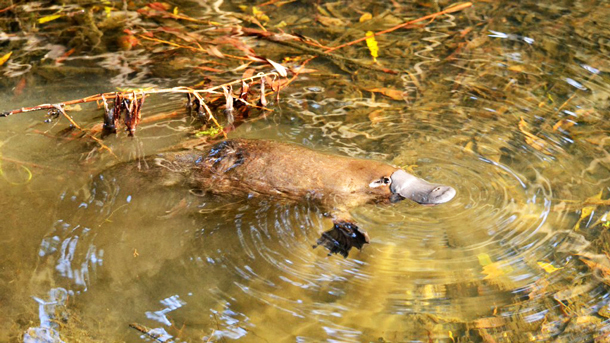
The duck-billed platypus is an extraordinarily well-adapted creature unlike anything else in the animal kingdom – despite the fact that the kinds of streams where it lives are hardly unique to Australia. (Photo: Klaus, Wikimedia Commons)
How much evolution is a matter of chance and how much its course is inevitable is a matter of prolonged debate explored in a new book from evolutionary biologist Jonathan Losos. Its called Improbable Destinies: Fate, Chance, and the Future of Evolution, and Jonathan Losos explained to Living on Earth’s Helen Palmer that examples from different ecosystems show nature’s inventiveness often runs on parallel tracks, but not the same one. With telling examples from research, he argues that the continued study of how evolution works is essential to human adaptation in a changing world.
Transcript
CURWOOD It’s Living on Earth, I’m Steve Curwood.
Ask someone about evolution, and they’ll likely point to Charles Darwin, his finches, and the survival of the fittest. Asked if evolution is inevitable, some might note the role of chance, such as the giant asteroid that killed off the dinosaurs.
And now there is a new book by evolutionary biologist Jonathan Losos that considers the roles of both chance and inevitability in how species evolve. It’s called Improbable Destinies -- Fate, Chance and the Future of Evolution. Jonathan Losos is the curator of herpetology, lizards and the like, at the Harvard Museum of Comparative Zoology, and Living on Earth’s Helen Palmer went to meet him in his office there.
PALMER: Jonathan Losos, the subtitle of your book, "Improbable Destinies”, is “Fate, Chance and the Future of Evolution". To leave aside the future for a minute and look at the past, is evolution fate or chance?
LOSOS: Well, it's some of both, but I think there's a large component of chance, that if events had happened differently in Earth's past, I think evolution very likely would have taken a different course, and the outcome might be very different from what we see today. If the dinosaurs hadn't been wiped out by that asteroid, I think it's very reasonable to say that they would still be here today, and if the dinosaurs were here today, it seemed reasonable that we - we being mammals - would still be skulking in the underbrush like little possums or rats.
PALMER: Is it inevitable that there would have been a superior, bigger brained race of some kind on the Earth? Is that kind of evolution that the fittest survive, and it becomes more and more complex, is that kind of evolution inevitable?
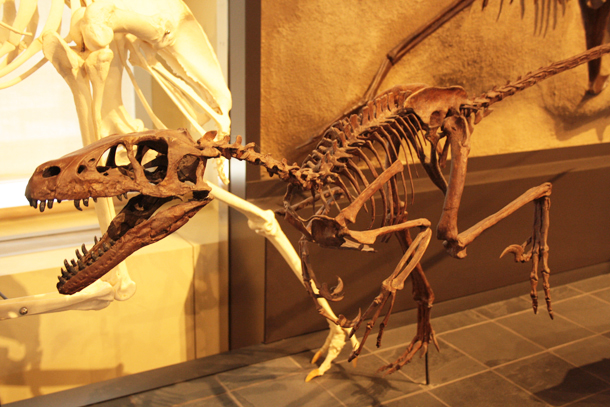
With its relatively large brain, Velociraptor was probably pretty clever, and had it not been wiped out with all the other dinosaurs 66 million years ago, Losos says it’s very possible Velociraptor’s brain would have continued to grow. (Photo: Shankar s., Flickr CC BY 2.0)
LOSOS: Well, that's a great question, and that's one that's been debated for a long time. We can well imagine that there is an advantage to being more intelligent, and so that natural selection may well favor organisms with bigger brains that are smarter. And so, if the asteroid hadn't wiped out the dinosaurs, well maybe it's the dinosaurs that would have evolved to become more and more intelligent. If you recall Velociraptor, everyone's favorite or maybe not their favorite from Jurassic Park, where they were portrayed as being pretty intelligent – Remember, they outwitted the Safari Hunter, and they could open doors, and they were very clever, and that's because by dinosaur standards they had pretty large brains. If those animals had survived, and if natural selection had continued to favor the most intelligent of them, we can imagine that dinosaurs would have evolved very large brains, perhaps comparable to what we have.
Now, does that mean they would look like us? Probably not. The theropod dinosaurs of Velocity Raptor and Troodon were related to T-Rex and to Allosaurus, and so these were animals that were already bi-pedal, walking on two legs. They had hands that were used for grasping, but they also had a long tail, and so they probably would have continued in that body form and just developed a big head and probably a big tail to balance that head. But the other thing is, they probably had feathers, and so we're now really talking about an animal on two legs with a long tail, grasping hands, a big brain, covered with feathers. Kind of like a super-sized chicken as I think what they would have looked like.
PALMER: [LAUGHS] It's mind-boggling to imagine such a thing actually.
LOSOS: You know, it could have been.
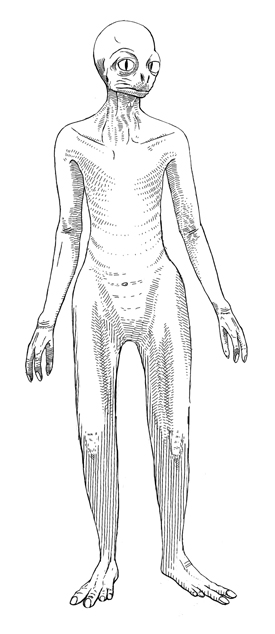
Canadian paleontologist Dale Russell speculated that a modern-day descendant of Troodon, a relative of Velociraptor that was also pretty brainy, would look something like the above illustration; he called it a “dinosauroid.” (Photo: Marlin Peterson)
PALMER: You concentrate on a kind of Caribbean lizard called the anole. Tell me why it's a really good study subject, and tell me what's happened to your own research on it.
LOSOS: Well, anoles are a particularly good organism to study evolution because they're a great evolutionary success story. There are 400 species of them, and you can walk close to them and they will just continue doing what they do and not be too disturbed. Then you can catch them, you can bring them back in the lab. You can study their behavior in the lab. You can study their physiology. We can look at their genetics, at their DNA. How is it that these lizards have gotten to be so successful?
PALMER: You've also discovered that different species on different islands all evolved to take advantage of a particular ecological niche.
LOSOS: Yes, probably the most interesting aspect of these lizards is that on the large islands of the Caribbean - That's Cuba, Puerto Rico, Jamaica and Hispanola - each island, the lizards have diversified independently. That's to say, all the species on Jamaica are descended from a single ancestor, and yet when you look at the species that have been produced, they have produced the same types of habitat specialists.
So, for example, in Puerto Rico, say, you went into the rainforest in the Luquillo mountains before it was flattened by a hurricane -- It will come back -- Anyway, if you went to the rainforest and you sat quietly, after a few minutes the lizards would forget you were there, and you would see that there are a number of different species living in different parts of the habitat. You have one species that lives on the tree trunk near the ground and has very long legs and is very good at running to the ground or jumping to the ground to confront its fellow lizards, or to eat food, or whatever.
You have another species living on twigs, on narrow surfaces. It has very short legs, and it moves very slowly, cautiously, over the narrow irregular surfaces it uses, and it's very well camouflaged because it can't move very fast.
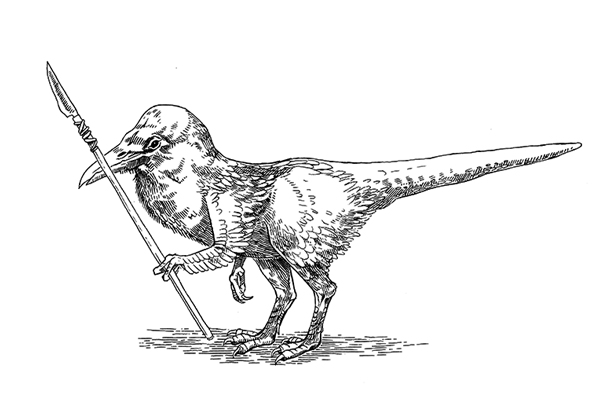
Some evolutionary biologists now propose that if the dinosaurs had survived, it’s not obvious their brainy descendants today would be similar to humans. They might in fact look something like a super-sized brainy chicken. (Photo: Marlin Peterson)
And then high in the tree you have another species. It's green, so it blends in with the vegetation, it has big toe pads that allow it to stick onto, onto the leaves it's hanging out. So, within one place the species have adapted to use different parts of the environment. But the really fascinating thing is that, when you go to another island, you see the same set of habitat specialists. So, you have a twig species almost identical to the one in Puerto Rico, but it's not closely related, and then you've got another one high in the trees, green with big toe pads just like the Puerto Rican one and another one on the ground and so on.
PALMER: But these are actually different species. They're not the same species, sort of like just jumped from one island to another.
LOSOS: No, that's correct. They are different species and the similar ones on different islands are not closely related to each other. When we look at their DNA, that becomes very clear. All the species on Jamaica are more closely related to each other than they are to the similar ones on other islands.
And so what that means is that these twig anoles, as we call them, have evolved four times, once on each island. This is a phenomenon we call convergent evolution when species evolve to be similar, and it's a very old phenomenon. Darwin knew about it, but what's particularly interesting with these lizards is that it's not convergence of a single type, like the twig anoles, but of an entire ensemble of different habitat specialists.
PALMER: In other parts of the world it's not lizard species that evolved to use habitats, it's a totally different species, particularly, if you look at the place like Australia, you point to how very different the fauna is there even though it’s occupying the same kind of spaces as creatures in other parts of the world.

On Jamaica – just like on other Caribbean islands – one species of anole lizards has diversified into four different species (clockwise from top left): Garman’s anole (green guana); Graham’s anole; Jamaican bush anole; Jamaican twig anole. (Photo: Marlin Peterson)
LOSOS: Well, this is one of the debates that I get at, at my book, of how deterministic is evolution, is the same outcome necessarily will occur, and on the islands I study in the Caribbean, it turns out it is pretty deterministic. If you put a lizard on a Caribbean island, it will diversify and produce the same set of species time and time again. On the other hand, that's not always the case. There are species that evolve to adapt to their particular circumstances in ways that no other species has done, and my favorite example of that is the Duck-billed platypus.
Now the duck-billed platypus gets a bad rap. People think it's some ridiculous mishmash of parts that can only survive you know off in Australia where everything is a misfit or something like. That's really completely unfair. The platypus is an extraordinarily well-adapted animal. It lives in streams in Australia, and it has features, well, it's got very thick fur so it can tolerate very cold temperatures. It's got a powerful tail. It's got webbed feet to swim. Its most extraordinary feature, though, is its bill which is covered with receptors that can detect both slight ripples in the water, but even more amazingly it can detect electric discharges, that when a crayfish moves its muscle there's a little discharge, and the platypus can pick that up with its bill and can find the crayfish just by those electric discharges. So, really exquisitely adapted to its environment.
Well the place that it lives, these streams in eastern Australia, streams and ponds, there's nothing special about them. There are streams and ponds like that here in North America and Europe, all over the world and yet nothing like the duck-billed platypus has evolved anywhere else. It's a unique solution to a common problem and so that illustrates that evolution isn't always predictable. You put species in a similar environment, they may not adapt in the same ways.
PALMER: I think most of us, if you ask most people, they would tell you that evolution is a slow process. It's something that works over eons or maybe sometimes, as Stephen Jay Gould suggested, there's this punctuated equilibrium that it's a bit jerky, but typically that it's slow. But you point out that in some cases it actually happens quite fast.
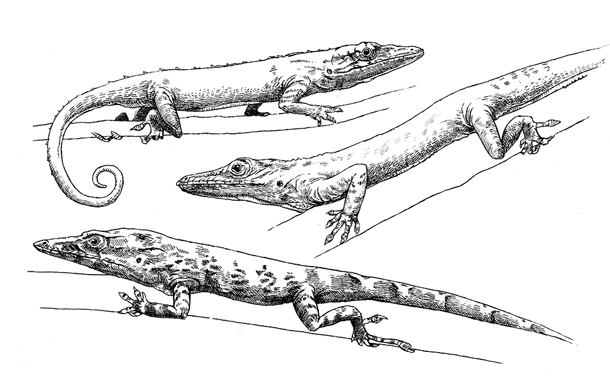
The Caribbean islands of Hispaniola, Puerto Rico, and Cuba all have twig anoles (shown above from top to bottom, respectively) that independently evolved to have very similar features. (Photo: Marlin Peterson)
LOSOS: That's correct. We used to think that evolution was a very slow gradual process, that it took eons, thousands of years, before you could detect the difference, and that idea really traces back to Darwin. Now, Darwin in his day had no direct evidence about evolution in nature. It was his intuition that led him to believe that evolution would occur slowly. Darwin was right about a remarkable number of ideas he had, from evolution by natural selection to how atolls are formed to how worms produce mold. And so, when Darwin said something, we tend to assume he got it right.
It turns out, this is one example where he didn't. We now know that, when natural selection is strong, evolution can occur very rapidly. And now evolutionary biologists, actually the expectation is that, when environments change, we will see rapid evolution, and of course, the environment is changing radically right now, thanks to all the ways we're changing the world, and so it's not surprising to think that evolution could be occurring very rapidly even right around us.
PALMER: And your experiments with anoles and the leg length demonstrates that it can happen very fast because the ones with longer legs were falling off the twigs, for instance, and didn't survive.
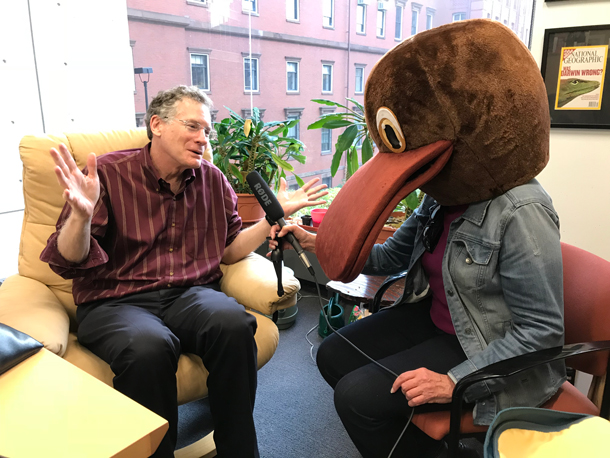
In addition to lizards, Jonathan Losos likes platypuses so much that his office is crawling with plush platypuses, small figurines and a gigantic custom-made platypus costume (worn in the above photo by Living on Earth’s Helen Palmer). (Photo: Jenni Doering)
LOSOS: Exactly. Since we know that evolution can occur rapidly, that means we can actually do experiments on evolution, something that that Darwin, who was a great experiment, never even considered. So, some people are actually setting up experiments, changing conditions and seeing if they can observe evolution in real time.
And that's what we did with lizards. We put them in a situation where we thought that natural selection would favor shorter legs, and we asked, over a few years would they actually evolve shorter legs? And the evidence indicates that they do.
PALMER: Fast.
LOSOS: Yes, very fast. A couple of years. So, you can write a five-year grant -- I'm going to look for evolution, and you could reasonably think that you might find it.
PALMER: One of the experiments that you write about, one of the most fascinating experiments is the one that's done at Michigan State by Rich Lenski and his team. Can you explain what that is?
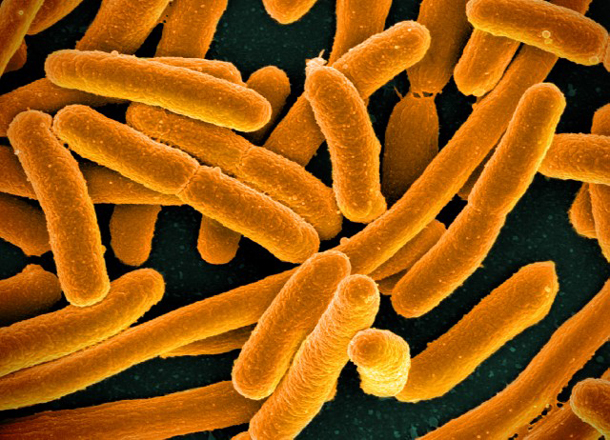
The Long-Term Evolution Experiment, or LTEE, has been running for 30 years now and its 70,000 E. coli generations have produced surprising evolutionary results. (Photo: NIAID, Flickr CC BY 2.0)
LOSOS: Well, this is a spectacular experiment. What Lenski did is, he wanted to ask this question, how repeatable is evolution? How destined is it to produce the same result time and time again?
And so what he did is, he took a strain of E. coli, the bacteria, and put them in a new mixture of nutrients to which they were not well adapted, and so he predicted that the bacteria would have to evolve to adapt to the new conditions. However, he didn't do this with just one test tube of them, actually in a flask, but he made 12 flasks all drawn from the same source, so they were all faced with the same challenge. They started identically. Would they adapt in the same way? He initially planned to do this experiment just for six months or so, but it just was so fascinating he kept on doing it, kept on doing it. Now he's been doing it, he and a lab full of brilliant scientists working with him, they've been doing it for 30 years for 70,000 E. coli generations, and they've watched how these 12 independent replicates have adapted to the same resources.
PALMER: So, exactly what have they found? Have they gone absolutely down parallel tracks?
LOSOS: Well, that's the fascinating thing. For the first 15 years of the experiment, for the most part, the 12 populations did the same thing. There is a little bit of variation. There are some interesting twists, but for the most part you could characterize it as, they are adapting in the same way to the same conditions.
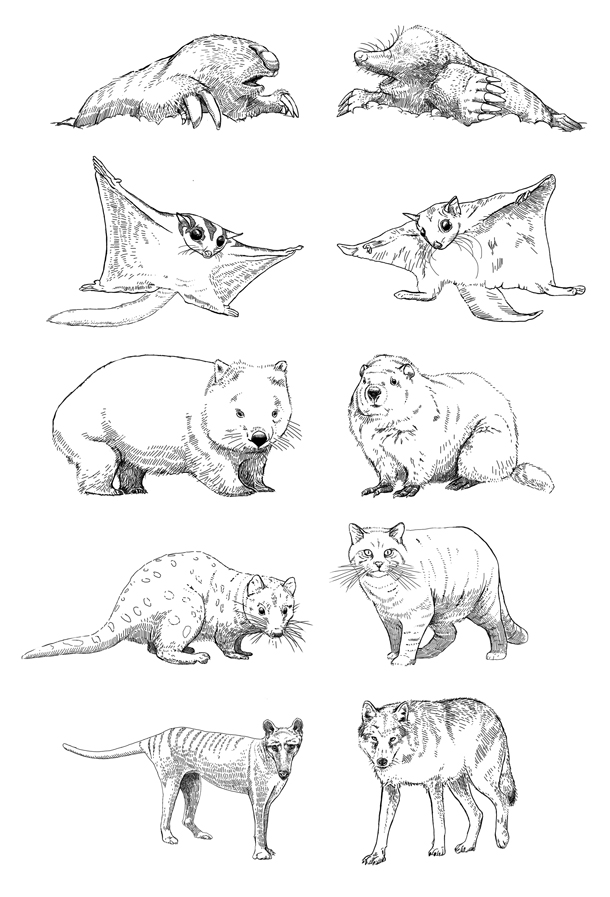
Evolution often produces quite similar kinds of species from entirely different branches of the tree of life. Above, Australian marsupials and their convergent placental counterparts (from top to bottom): marsupial mole—mole; sugar glider—flying squirrel; wombat—groundhog; quoll—wild cat; thylacine—wolf. (Photo: Marlin Peterson)
And then, 15 years into the experiment, one population found a way to adapt to these nutrients in a way that was completely different from any of the other 11 populations, in fact, different from any other E. coli that had been studied in the lab. A vastly different adaptation, so much so that you might consider it a different species. And to this day none of the other 11 populations have found that solution.
So, here's a clear example that evolution isn't always deterministic, that even though the 12 populations started identically, they faced the same circumstances, one of them found a very different way to adapt to the situation.
PALMER: So, how did it do it? Was it sort of like dumb luck? Was it clever reasoning? I mean, what happened was, they were fed glucose, and this one population evolved to use citrate, which was just a stablizer in there, and none of these E. coli can eat citrate except for this one. So how did it do it?
LOSOS: Well, it's a bit complicated in terms of microbiology, but the simple version is this. There was citrate in the nutrients that they were provided, for technical reasons. They weren't expected to eat the citrate. In fact, equal E. coli cannot eat citrate in the presence of oxygen, and so it was just there for other reasons. But this one population found a way to be able to take in the citrate, and the way that happened is that there were at least three mutations that just happened to come along and just happened to come along in the right order, and that they allowed it to change around the molecular machinery in a way that they were able to take the citrate in.
PALMER: So, this is basically an example of chance. It was chance that these mutations happened in the right order.
LOSOS: Exactly.
PALMER: The third part of the book's title is "The Future of Evolution". What is the future of evolution do you think?
LOSOS: Well, you can answer that question in a number of different ways. At one level, evolution is going on all around us. As we said earlier, evolution can occur very rapidly when the environment changes, and we are changing the environment in very many different ways, and so organisms are adapting to these changes, and these evolutionary adaptations actually affect us as well in a variety of ways.
-Riverhead.jpg)
Jonathan Losos is a biology professor and director of the Losos Laboratory at Harvard University and Curator of Herpetology at Harvard’s Museum of Comparative Zoology. (Photo: Rose Lincoln / Riverhead Books)
On the one hand, there are species we consider pests, rats and various insects and various weeds, that we don't like because they inconvenience us or cause us economic hardship or even cause us medical problems. And we try to get rid of them by developing pesticides of various sorts. Well, these rascals are evolving resistance to our efforts often very successfully. We see the same thing with the microbes that are evolving to attack us, and we try to poison them with drugs, antibiotics, and they are evolving resistance, and this is a huge problem because it is killing people. And so, again, this is the result of evolution, species adapting to the measures that we are developing to control them. And so, evolution is going on all around us, and we need to understand it in order to try to shape evolution to our benefit.
And lastly, of course, there are species that are endangered by the changes in the world. Global warming is a real threat. Many species are having trouble at coping with it, and the question is, will they be able to adapt to a warmer world or a world that is drier or whether or or wherever they happen to live? Evolution is not some academic subject that only pointy-headed scientists in their labs care about. It is affecting the world around us and has real consequences for us.
CURWOOD: Jonathan Losos. His book is called Improbable Destinies -- Fate, Chance and the Future of Evolution. He spoke with Living on Earth’s Helen Palmer.
CURWOOD: And join us next time to learn how that tail-wagging, adoring companion of yours can help you live longer. Dogs and human health benefits, next time on Living on Earth.
Links
Improbable Destinies: Fate, Chance, and the Future of Evolution
The Losos Laboratory at Harvard
Ars Technica: “Evolution experiment has now followed 68,000 generations of bacteria”
Living on Earth wants to hear from you!
Living on Earth
62 Calef Highway, Suite 212
Lee, NH 03861
Telephone: 617-287-4121
E-mail: comments@loe.org
Newsletter [Click here]
Donate to Living on Earth!
Living on Earth is an independent media program and relies entirely on contributions from listeners and institutions supporting public service. Please donate now to preserve an independent environmental voice.
NewsletterLiving on Earth offers a weekly delivery of the show's rundown to your mailbox. Sign up for our newsletter today!
 Sailors For The Sea: Be the change you want to sea.
Sailors For The Sea: Be the change you want to sea.
 The Grantham Foundation for the Protection of the Environment: Committed to protecting and improving the health of the global environment.
The Grantham Foundation for the Protection of the Environment: Committed to protecting and improving the health of the global environment.
 Contribute to Living on Earth and receive, as our gift to you, an archival print of one of Mark Seth Lender's extraordinary wildlife photographs. Follow the link to see Mark's current collection of photographs.
Contribute to Living on Earth and receive, as our gift to you, an archival print of one of Mark Seth Lender's extraordinary wildlife photographs. Follow the link to see Mark's current collection of photographs.
 Buy a signed copy of Mark Seth Lender's book Smeagull the Seagull & support Living on Earth
Buy a signed copy of Mark Seth Lender's book Smeagull the Seagull & support Living on Earth

